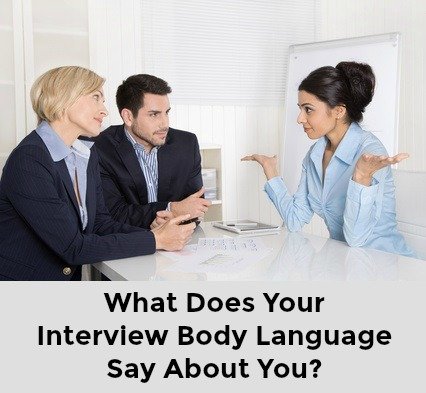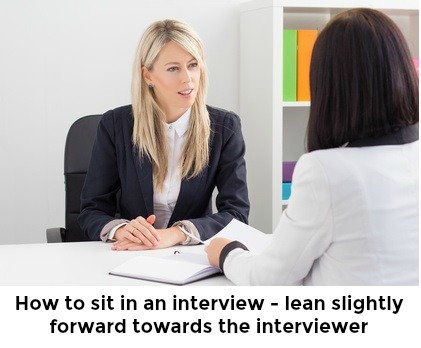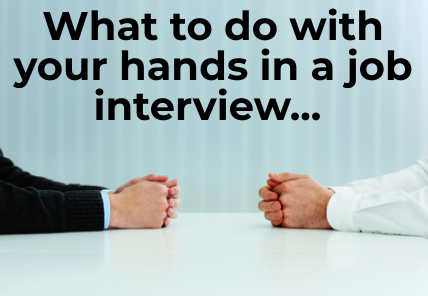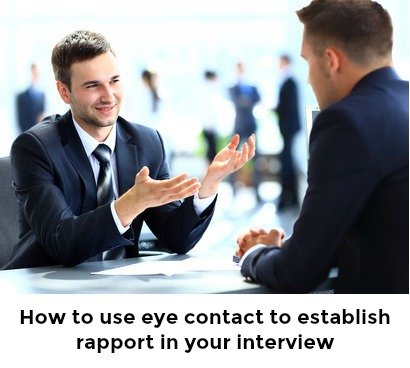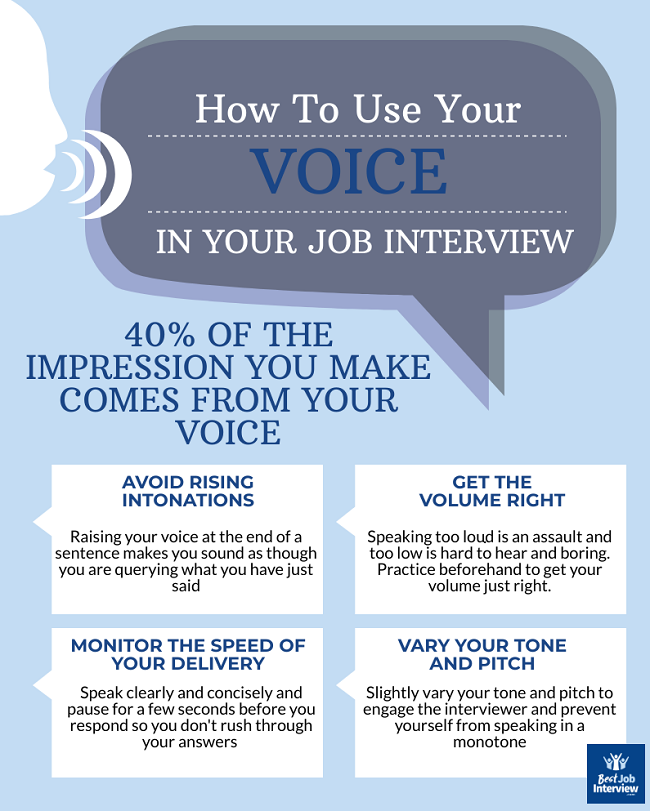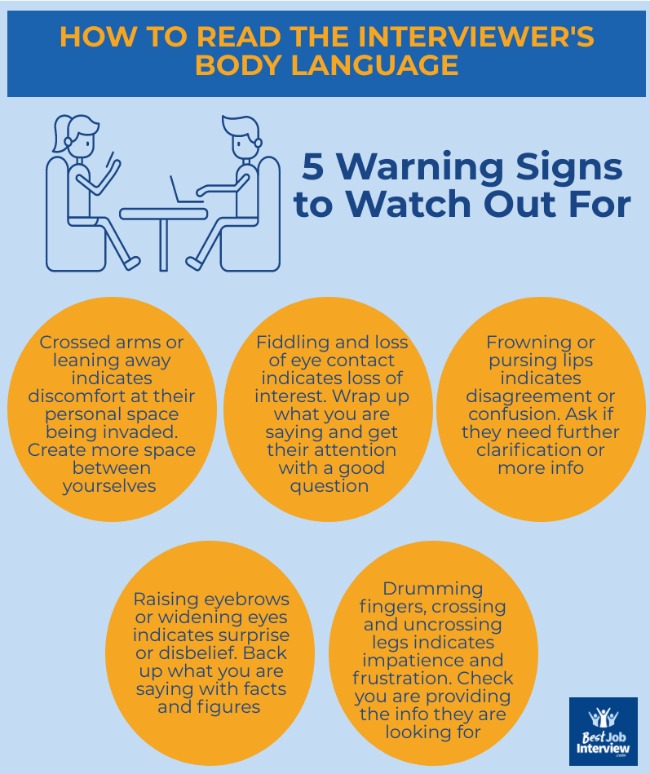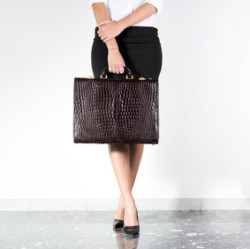- Home
- Interview Tips
- Interview Body Language
Interview Body Language
that
Sends the Right Message
Why is interview body language important? Non-verbal communication accounts for over 90% of the message you are
sending in your job interview so it is essential to get it right.
Your interview posture, what you do with your hands, how you make eye contact and the way you speak such as your voice tone are as important as the actual words you use in your job interview answers.
8 Essential Interview Body Language Tips
Non-verbal communication tips for job interviews.
1. Interview posture - how to sit in your interview
What is the best posture in an interview?
When the interviewer offers you a seat at the start of the job interview, sit upright but not too stiffly in your chair. This indicates that you are comfortable and feeling confident. Hunching down in your chair gives the impression of nervousness and low self-esteem.
A sloppy posture indicates a careless attitude and a lack of energy. Sitting on the edge of your chair can come across as being nervous and tense.
- Relax and lean slightly forward, about 10 degrees, towards your interviewer. This gives the message that you are both interested and involved.
- Leaning back makes you appear too casual. Leaning to the side can be perceived as not feeling comfortable with the interviewer.
How you position your head also sends a message.
- Tilting your head very slightly to one side comes across as friendly and open.
- Keeping it straight comes across as self-assured and authoritative.
2. Mirror the interviewer's body language
It is important to pay attention to the posture of your interviewer. You can establish rapport by adopting the same posture as the other person. This is called mirroring.
If they have adopted a more formal posture do the same until you see that the interviewer has relaxed and become less formal.
3. Interview body language - what to do with your hands
If you are unsure of what to do with your hands, rest them loosely clasped in your lap or on the table in front of you.
Control your hands by being aware of what you are doing with them.
- Having your hands above the neck, fiddling with your face or your hair, is unprofessional and conveys nervousness and anxiety.
- Keep your hands away from your face. Interview body language experts will tell you that touching the nose or lips can indicate that the candidate is lying or uncertain.
- Folding your arms across your chest suggests a closed and defensive attitude.
- Waving your hands and arms around can be perceived as uncertainty and a lack of professionalism. Common wisdom is that the less you move your arms and hands about the more confident and in control you are.
- Practice a comfortable way to loosely place your arms and hands while you are sitting, both at a table and in a chair on its own.
4. Be aware of your legs
Be aware of the interview body language message your legs are giving.
- Lots of leg movement is both distracting and indicates nervousness.
- Resting one leg or ankle on top of your other knee makes you look too casual and comes across as arrogant.

- Crossing your legs high up conveys a defensive attitude in the one-on-one context of a job interview.
- Crossing them at the ankles or placing both feet flat on the floor conveys a confident and professional look during the job interview.
5. Make eye contact and build rapport
If the interviewer is talking and you want to show that you are actively listening, you need to instigate direct eye contact and maintain it.
Avoid appearing as if you are staring aggressively by blinking at regular intervals and moving your head every now and then, such as giving a small nod.
- Interview body language experts suggest that when you are doing the talking you need to hold eye contact for periods of about 10 seconds before looking away briefly and then re-establishing eye contact.
- Over-using direct eye contact when you are speaking can come across as challenging the interviewer.
- Typically the listener maintains direct eye contact for longer than the speaker who breaks it off at intervals.
- Looking constantly downwards makes you appear insincere or submissive. It is acceptable to look down if you are making notes or referring to information in front of you.
- However if you are speaking, or the interviewer is asking you something, raise your head and make regular eye contact to show that you are actively involved.
- With panel interviews it is best to look at and direct your answer to the person asking the question, with a glance periodically at the other interviewers.
- Eye contact is essential interview body language to establish rapport with your interviewer.
6. What about facial expressions during your interview?
Interview anxiety can make candidates appear distracted and unenthusiastic. Making a conscious effort to smile is key to overcoming this. Smiling will help build rapport and create a friendly and confident impression.
However in order for the smile to appear genuine and for it to be appropriate, let your smile come and go and smile at the right time.
Don't discuss serious or difficult issues with a grin on your face.
Sometimes frowning or pursing your lips is an unconscious response when you are thinking about a question. However this can be interpreted as annoyance, incompetence or disapproval. The best thing you can do to avoid this is to pause and look away for a few seconds, this will demonstrate that you are considering the question and your answer.
7. How to monitor your voice delivery
Speaking in a clear and controlled voice conveys confidence.
- Avoid speaking in a monotone by varying your tone and pitch, however don't overdo it and come across as overly excited or emotional.
- Breathe and pause before answering a question, this gives you time to react in a considered way and it ensures that the interviewer has finished the question.
- You should interact with the interviewer as an equal, not a subordinate. Ensure that your voice tone is not apologetic or defensive.
8. Avoid displaying too much emotion
Generally it is advisable not to show too much or too strong emotion
during your job interview. Smile and nod at appropriate times but don't
overdo it. Avoid intense facial expressions, gesticulations and erupting into laughter on your own.
How to read the interviewer's body language
Watch for these interview body language signals from your interviewer to read the message they are sending you.
- Body language cues that can indicate boredom include resting head on hand, fiddling with hands and losing eye contact. If this happens wrap up what you are saying and move on by asking the interviewer a question such as: "Is there anything else you would like to know about that topic?"
- Drumming fingers and rubbing the face can indicate irritation. Clarify that you are answering the question with the information they want and not frustrating them with an off-the-point response.
- If the
interviewer crosses arms or leans away it could mean that they are
feeling uncomfortable. Consider your interview body language. Perhaps
you are leaning in too
close and invading their space in some way.
- Be aware of personal space. If there is not a table between you that creates a safe degree of personal space, keep a distance of about two to three feet, this is a comfortable amount of personal space for most people.
Send the right message with your interview clothes
What message do your interview clothes send? Know how to dress for an interview and make the right first impression.
Practice with this mock interview
Preparing for your job interview includes not only knowing what to say but how to say it. The best way to be aware of your interview body language and the way you are coming across is to practice in front of a mirror. This way you can be confident that you are sending the right message in your job interview.
Use the mock job interview to help you.
Quick Links to Top Job Interview Tips
Be ready for any interview question you may have to answer. Go to these sample job interview questions
